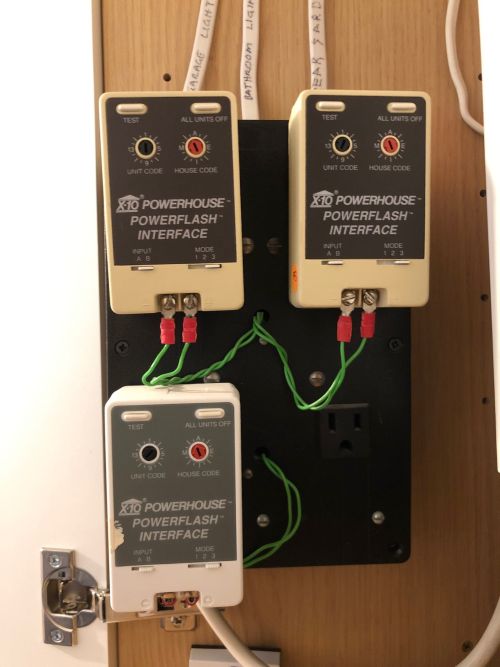 When our property was built in 1989, we had a Southern Electric Electratech System installed, which used impulse relays in the consumer unit.
When our property was built in 1989, we had a Southern Electric Electratech System installed, which used impulse relays in the consumer unit.
However, this system was hopelessly unreliable, and Southern Electric paid to replace it with X-10 modules, passing future maintenance and repair responsibility onto us, which we accepted.
Here I show photographs of our X-10 system as currently installed, including:
- The fuse box with DIN appliance and Powerflash modules.
- The Study where the computer interfaces are.
- Transceiver units, located in a central area.
- Appliance modules controlling irrigation
- Stanley motion detector
- A talking motion detector
The Fuse Box
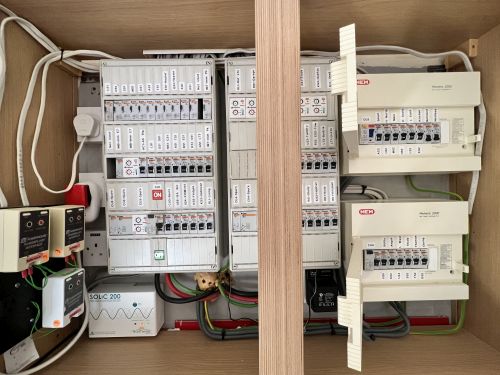 Here you can see the split power supply and the DIN appliance modules. The DIN modules control the space and water heating; the ventilation system; the outside lights and the two internal lighting rings.
Here you can see the split power supply and the DIN appliance modules. The DIN modules control the space and water heating; the ventilation system; the outside lights and the two internal lighting rings.
On the far left are three Power Flashes that are plugged into the black box; these Power Flashes are 115V USA units that I have modified for the UK's 230V operation, and they send signals through the mains wiring to indicate where outside movement has been detected.
The Study
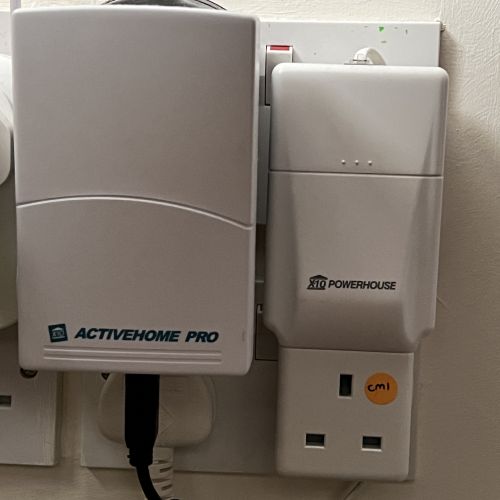 All on-off times are controlled by the Homeseer and X-10 Activehome software running on a Lenovo T series ThinkPad.
All on-off times are controlled by the Homeseer and X-10 Activehome software running on a Lenovo T series ThinkPad.
The Thinkpad is connected to the CM12U (right) via the serial interface and the CM15 (right) is connected via a USB interface.
You can just see the auto-transformer behind the CM15 that delivers 115V to the CM15 via the black mains cable; this transformer has been modified by myself to allow the X-10 signals to bypass the high inductance of the transformer windings.
Transceiver Units
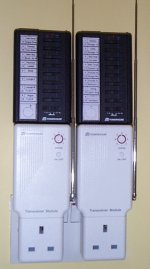 The picture on the left shows the UK Transceiver units for both house codes "A" and "B".
The picture on the left shows the UK Transceiver units for both house codes "A" and "B".
Normally the Dell controls the appliances, but the programmed settings can be overridden by the transmitter units that are resting on the receivers.
We also have some USA Transceiver units that I have modified for 230Volt operation, and these are using house codes "C", and "D".
You cannot control UK receivers with USA transmitters, and vice-versa because they operate at different RF frequencies.
Appliance Modules
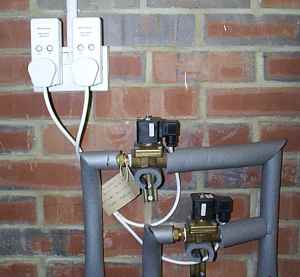 Here you can see two appliance modules that control the two solenoid-operated water valves that turn on and off the water to our micro-irrigation system.
Here you can see two appliance modules that control the two solenoid-operated water valves that turn on and off the water to our micro-irrigation system.
This minimizes the use of water which is just as well since we are metered.
Since this equipment is in the garage, the water pipes are lagged and drained during the winter months.
Stanley Motion Detector
I have modified imported Stanley external motion detectors to work from 230V instead of 120V. These have been installed outside the bungalow to provide all-round cover. These are robustly built units that have the significant advantage of neither requiring batteries nor an adjacent USA transceiver unit. These units have sophisticated X-10 signal generation options and communicate with the CM12U.
Talking Motion Detector
We have standard PIR motion detectors that illuminate around the bungalow when motion is detected. These standard units, available from DIY outlets are wired with a 4-way mains cable in which the 4th wire is the sense wire which goes to 230V when motion is detected.
The 230V is then applied to a transformer (one transformer for each detector) where it is rectified and smoothed to 12V DC. The 12V DC is then applied to the input of a Power Flash when then sends X-10 signals through the mains wiring. These X-10 signals are picked up by the CM12 and processed by the HomeSeer software.
The Homeseer then talks via the loudspeaker in the ThinkPad to explain where the motion is detected. The incidents are also logged and optionally sounds a chime module in another room. This feature was designed by myself, published in Computer Shopper magazine, and is very useful to detect visitors early.
